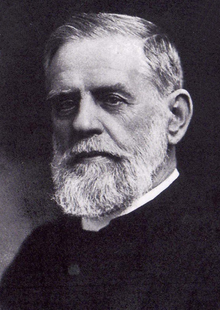William Campbell (missionary)
The Rev. Dr William Campbell | |
|---|---|
 An engraving of Campbell as depicted in his book Sketches from Formosa | |
| Born | 1841 Glasgow, Scotland |
| Died | 9 September 1921 (aged 79–80) Bournemouth, Dorset |
| Nationality | Scottish |
| Alma mater | Free Church College, Glasgow[1] University of Glasgow |
| Title | LL.D. |
| Signature | |
William Campbell (
Mission to Taiwan
Campbell arrived in
A strong supporter of "native ministers" (i.e. Han and aborigine clergy), Campbell wrote concerning one particular incident that
...our worthy Chinese colleague received a most hearty welcome from the brethren. He seemed to have great power in speaking to them at our forenoon service. [...] Whilst listening to him, one could not but feel the importance of having an educated native ministry in every part of China. Men like Pastor Iap are able to adapt themselves in a way the missionary can never do, and to overcome difficulties which must always hamper any mere sojourner in the country.[6]
Campbell witnessed Taiwan's transition to Japanese rule. His mission lasted for forty-six years, until he left Taiwan for the last time in 1917 to return to his native Scotland, where he died in 1921.
Published works
- Campbell, W.; OCLC 54336915.
- —————; OL 25396942M.
- ————— (1896). Past and Future of Formosa: With a New Map of the Island. Hong Kong: Kelly and Walsh. .
- OL 13995018M.
- ————— (1902). Notes on a visit to the Taichu prefecture of Formosa. Helensburgh: J. Lamont. OCLC 558224246.
- ————— (1903). Formosa under the Dutch: Described from Contemporary Records. London: Kegan Paul. OCLC 2532095.
- ————— (1906). Memorandum on Printing Missionary Books in the So-called South Formosa Dialect. Tainan. )
- ————— (1910). Handbook of the English Presbyterian mission in south Formosa. Hastings: F.J. Parsons. OCLC 37352945.
- ————— (1915). Sketches from Formosa. London: Marshall Brothers. OL 7051071M.
- ————— (1913). A Dictionary of the Amoy Vernacular spoken throughout the prefectures of Chin-chiu, Chiang-chiu and Formosa (in Minnan). Tainan: Taiwan Church Press. OCLC 39684248.
- ————— (1923) [1913]. A Dictionary of the Amoy Vernacular spoken throughout the prefectures of Chin-chiu, Chiang-chiu and Formosa (2nd ed.). Yokohama: Fukuin Print. Co. )
Notes
- ^ Campbell (1915), p. 15.
- ^ Chang, Teresa. "Taiwan's Medical Pioneers". Tzu Chi Quarterly. Archived from the original on 10 June 2011. Retrieved 11 August 2008.
- ^ Davidson (1903), p. 606.
- ^ Otness (1999), p. 25.
- ^ Covell (1998), p. 119.
- ^ Campbell (1915), p. 24.
References
- Campbell, William (1915). Sketches from Formosa. London: Marshall Brothers. OL 7051071M.
- Covell, Ralph (1998). Pentecost of the hills in Taiwan : the Christian faith among the original inhabitants. Pasadena, Calif.: Hope Pub. House. OL 681169M.
- OL 6931635M.
- Otness, Harold M. (1999). One Thousand Westerners in Taiwan, to 1945: A Biographical and Bibliographical Dictionary (1st ed.). Nangang District, Taipei: Institute of Taiwan History, Preparatory Office, Academic Sinica. ISBN 957-671-618-7.

